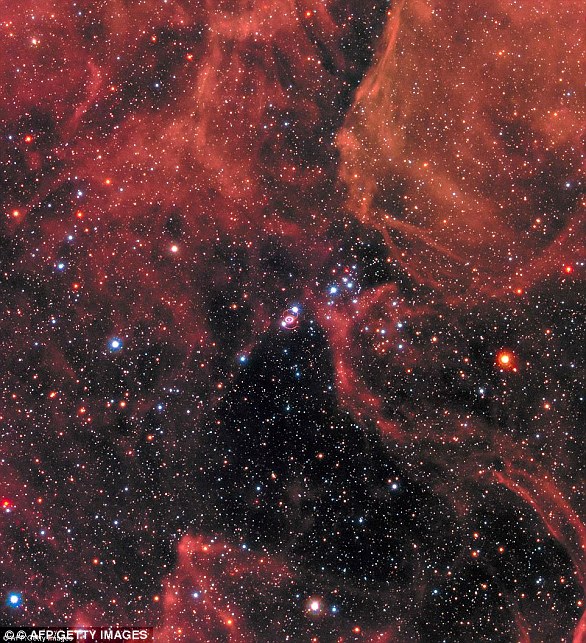Space might seem like an empty, featureless void, but new research has shown that this is far from true.
Scientists have discovered an ‘interstellar tunnel’ that connects our solar system to distant stars.
In a new study, scientists at the Max Planck Institute identified two hot tunnels, stretching across vast regions of space.
The researchers gathered thousands of measurements of the sky using the eROSITA X-ray telescope, a satellite launched in 2019.
This revealed that the sun is in the middle of a low-density bubble, around 300 light-years across, from which huge interstellar tunnels emerge.
One channel stretches out towards the constellation Centaurus, punching through the surrounding cool regions of space.
The other tunnel links our solar system with the constellation Canis Major.
The researchers believe these two channels may be part of a larger branching system that runs between different star-forming regions.
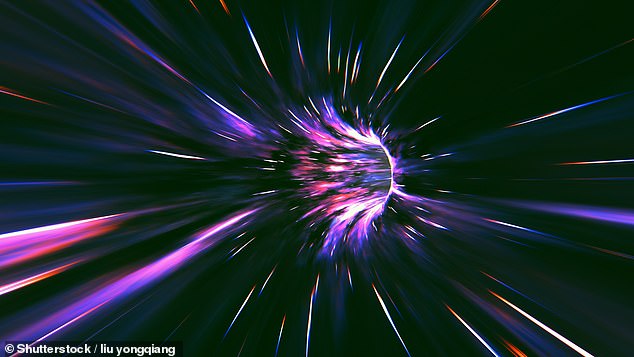
Space might seem like an empty, featureless void, but new research has shown that this is far from true. Scientists have been amazed to discover an ‘interstellar tunnel’ that connects our solar system to distant stars (stock image)
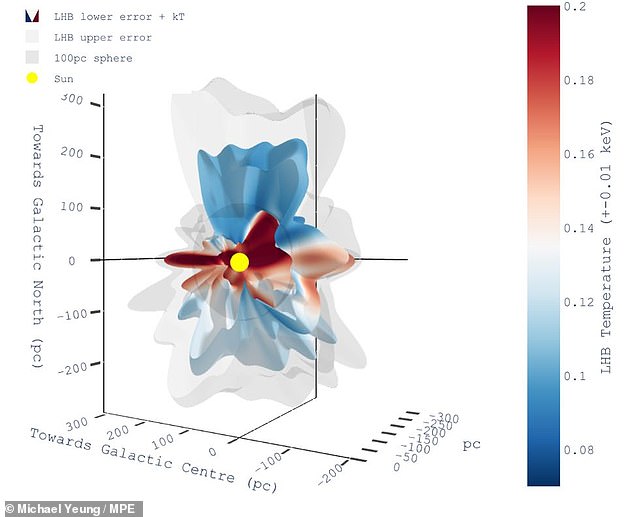
Scientists at the Max Planck Institute found two channels of hot, low-density plasma stretching out towards distant stars
Scientists have known for a long time that our solar system is in a strange pocket of hot, less-dense space known as the ‘Local Hot Bubble’.
This region is believed to be a ‘supernovae graveyard’, carved out by the explosions of dying stars 1`0 to 20 million years ago.
When extremely massive stars burn through all of their fuel, they collapse in on themselves and generate enough pressure to explode into supernovae.
These blasts create a wave of hot plasma that pushes gas and dust along with it, leaving behind a hot, low-density cavity.
The region was originally proposed to explain measurements of ‘soft X-rays’, photons carrying very small amounts of energy.
Since these soft X-rays can’t travel very far through space without being absorbed, the fact that we are able to detect them suggests that there could be an X-ray-emitting plasma that has pushed everything else out of the way.
By taking measurements from eROSITA, 930,000 miles (1.5 million kilometres) from Earth, scientists have been able to measure these very faint traces of radiation without the disturbances of Earth’s atmosphere.
These were combined with measurements from the German ROSAT X-ray telescope, which was launched in 1990, to make the cleanest X-ray map of the universe ever produced.
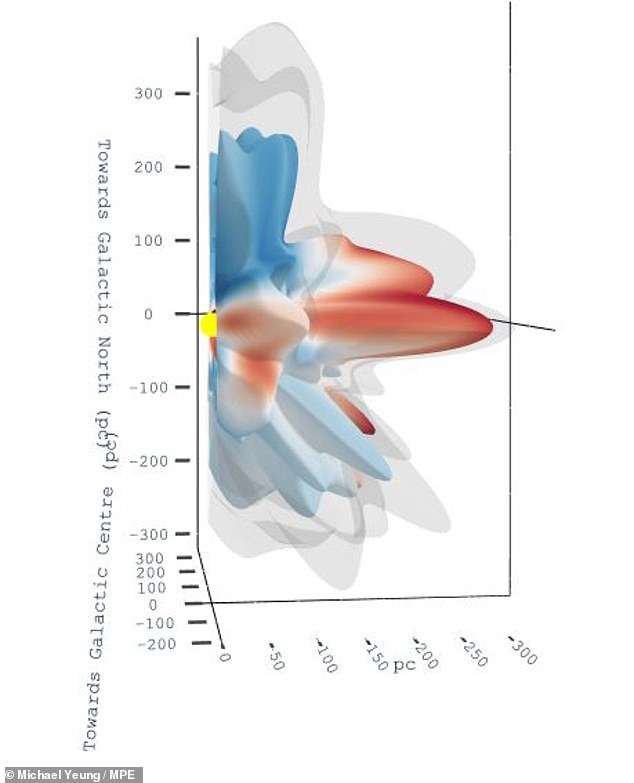
Our solar system is in the middle of a pocket of hot, low-density space called the ‘local hot bubble’ that was formed between 10 and 20 million years ago by supernova explosions
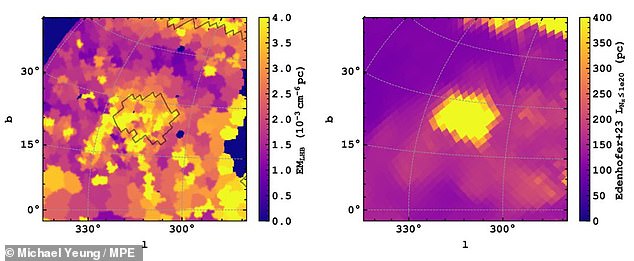
Scientists found a region of the bubble which is much warmer than the surrounding area. The researchers say this is an interstellar tunnel of hot space leading towards the constellation Centaurus
However, these very sensitive measurements also revealed something strange.
After dividing the Milky Way into 2,000 distinct regions, the researchers realised that the Galactic North was distinctly cooler than the Galactic South.
This means that the Local Hot Bubble is stretching away from the Galactic Disc, travelling in the direction of least resistance.
Co-author Dr Michael Freyberg, of the Max Planck Institute, says: ‘This is not surprising, as was already found by the ROSAT survey.
‘What we didn’t know was the existence of an interstellar tunnel towards Centaurus, which carves a gap in the cooler interstellar medium.’
This is in addition to a more precise measurement of the previously known interstellar tunnel leading towards Canis Major.
This tunnel is thought to stretch between the local hot bubble and the Gum Nebula, 1,500 light-years from Earth.
In their paper, published in the journal Astronomy & Astrophysics, the researchers say this ‘hints at the possibility of a widespread tunnel network connecting regions filled by the hot phase of the ISM [interstellar medium].’
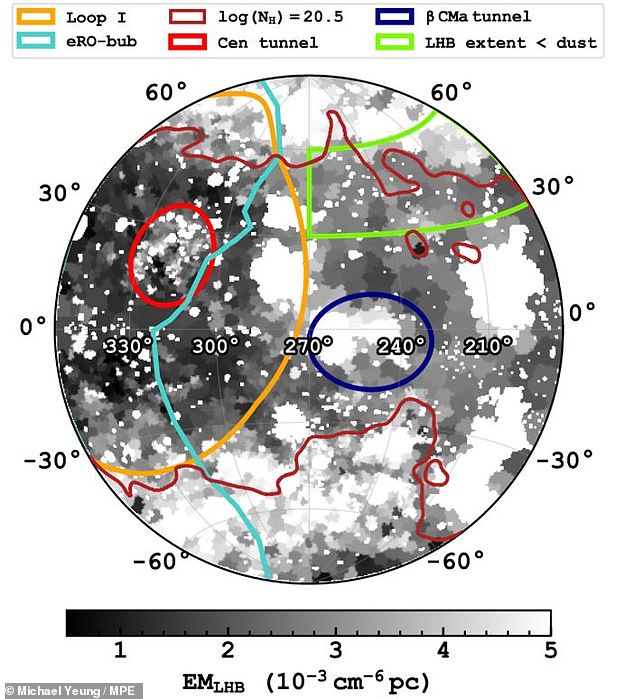
The researchers now say that our solar system is connected to distant regions of space by two channels. One leading towards Centaurus (bright red circle) and the other leading towards the constellation Canis Major (purple circle)
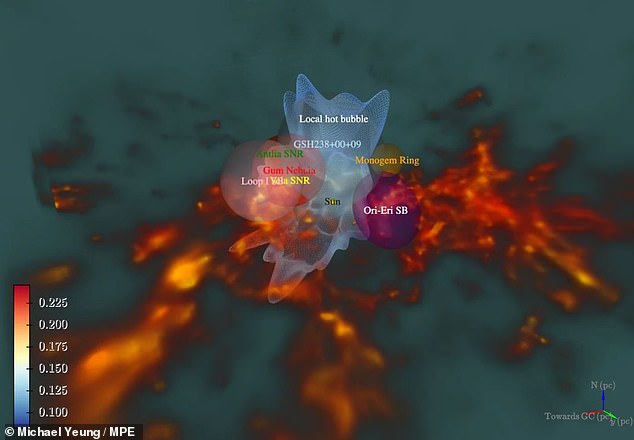
These tunnels may form part of a branching interstellar network which connects nearby star-forming regions (pictured)
This interstellar network is maintained by the explosive births and deaths of stars, which create powerful solar winds.
Previous research has shown that the supernova shockwave that created the Local Hot Bubble collected up gas and debris at its edge, creating the conditions for new stars to form.
These new stars then produce jets of hot gases and radiation, which push out until they reach other star-forming bubbles.
This process, known as ‘stellar feedback’, is believed to sweep across the Milky Way, shaping the structure of the galaxy as it goes.
This study also gives a fascinating hint at the origins of our own solar system.
The researchers say that our sun was not formed within the Local Hot Bubble, but only entered it by chance relatively recently.
Co-author Dr Gabriele Ponti says: ‘Another interesting fact is that the sun must have entered the LHB a few million years ago, a short time compared to the age of the sun [4.6 billion years].
‘It is purely coincidental that the sun seems to occupy a relatively central position in the LHB as we continuously move through the Milky Way.’

